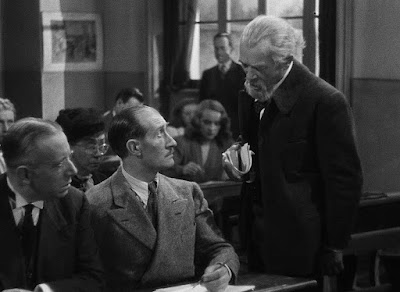 |
| Images courtesy of Janus Films |
Acclaimed French suspense maestro Henri-Georges Clouzot best
remembered for his searing Palme d’Or and Golden Bear winning 1953
action-thriller The Wages of Fear started a prolific filmmaking career
in the early 1930s with his short film Fear in the Batignolles before
beginning an extensive career in screenwriting.
Though co-directing two features in 1933, the director didn’t see his
first feature film through until 1942 with the comedy-thriller The Murderer
Lives at Number 21. Despite this,
the film opened in French theaters to universal critical acclaim. However, as Clouzot’s career was beginning,
it almost all came to a screeching halt following the inception and release of
his 1943 French horror film Le Corbeau translated to The Raven recently
picked up on Blu-Ray by The Criterion Collection.
As with his debut feature, Le Corbeau was one of a
handful of films Clouzot wrote for Continental Films, a Nazi German company
which took root during the Occupation of France. With the impetus behind Continental Films to
fill in the gap left by then-banned American movies amid the occupation, Le
Corbeau began initially as a true crime story involving a group of
anonymous letters sent with the signature ‘the eye of the tiger’ and the first
draft of the screenplay came from Louis Chavance with rewrites from Clouzot. Prominently starring Pierre Fresnay from the
director’s previous film, the early peek into Clouzot’s foray into the suspense
horror subgenre concerned a small French provincial town being turned upside
down in terror with a number of poison-pen letters penned by Le Corbeau. Primarily targeting a local doctor Rémy
Germain (Pierre Fresnay) with accusations of illicit extramarital affairs
and performing illegal abortions, the letters soon start hitting everyone in
the town creating violent escalation including the suicide of a patient.
An early ensemble piece co-starring Micheline Francey,
Ginette Leclerc and Pierre Larquey involving a small-town succumbing to the
grip of fear and anxiety, Le Corbeau is arguably the director’s first
true masterpiece as a sly and sneaky rebuke of the Nazi party. Initially rejected by the Nazis for
undermining their cause, the film is regarded as one of the first examples of
French film noir and following the film’s ban after the liberation of France it
became something of an underground countercultural hit. Though released commercially initially in
1943, it caused controversy right away when the right wing Vichy Regime, left
wing Resistance Press and the Catholic Church all universally supported banning
the film from exhibition altogether.
Whether it was criticizes for being ‘amoral’ or was seen as Nazi
propaganda for supposedly vilifying the French populace, the powers that be all
but threw the book at Clouzot.
Fired from Continental Films two days before the film
premiered, Clouzot and several other cast and crew members came under fire for
collaborating with the Nazi party and were tried in court over it. As a result Clouzot was banned (initially for
life) from making any films or setting foot on a set. While this went on, however, Clouzot saw his
share of defenders writing in his favor including Jean Cocteau (Beauty and
the Beast), Rene Clair, Marcel Carnet and Jean-Paul Sartre who contested
the sentence. Over time however,
Clouzot’s punishment was mitigated to two years and eventually the ban was
lifted. Though Clouzot himself got back
to work right away, the film remained banned still even after director Otto
Preminger did an English language remake in 1951 called The 13th
Letter.
Featuring luminous, frequently Dutch-angled noirish
cinematography by Orpheus cameraman Nicholas Hayer, the look of Le
Corbeau is gothic and threatening aided by brilliant editing from
Marguerite Beauge including a key sequence where a town meeting is held in a
church and a newly fashioned poison-pen letter casually falls from the ceiling
onto the floor below. The score by Annapurna
composer Tony Aubin is appropriately unsettling if not gloomy and
foreboding, augmenting the already uncanny borderline German expressionist
vistas of a small town overcast by craggy skinny trees while a mercurial
cloaked figure (possibly Le Corbeau itself) wanders the streets. Much of the film’s paranoid energies stem
from Pierre Fresnay who sadly broke off friendly relations with Clouzot
following its completion. Adding a bit
of a femme fatale energy to the saga is Ginette Leclerc as Dr. Germain’s
illicit lover/patient Denise Saillens.
Bringing debonair aristocratic energy to the proceedings is Pierre
Larquey as Dr. Vorzet who may know more about the mysterious letters than he
leads on.
While Clouzot’s career eventually did flourish into that of
an Award Winning master filmmaker, for years (and still to some extent) Le
Corbeau was seen as something of a cursed film considering its financial
backing. Still, against the ban it was
played in nightclubs to dedicated French cinephiles who nevertheless regarded
it as a masterwork. It wasn’t until
around 2016 that Criterion finally released the film in the United States for
the first time, allowing modern filmgoers to reassess this dark proto-horror
noir on its own terms. Seen now, it is
very plainly a rebuke of the Nazi occupation and is to some extent allegorical
for the overarching threat of life under occupation. In Clouzot’s oeuvre it is an important
stepping-stone that would propel (following his unbanning) him into the
stratosphere of the French New Wave as a wholly original and uncompromising
provocateur unafraid of roughing up his viewership with his often bleak outlook
on contemporary life. With an array of
films made with dirty money during the occupation, Le Corbeau is among
the few that gets away clean and seemingly triumphs artistically over its
illicit origins and an early sign of the director’s evolving artistic
genius.
--Andrew Kotwicki





